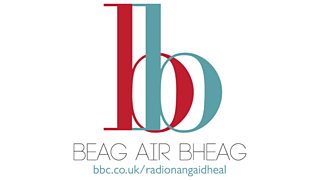Blasad Beag - Episode 11: Greetings
Halò! Fàilte air ais gu Blasad Beag, an earrann dhan phrògram dhuibhse a tha dìreach air tòiseachadh ag ionnsachadh Gàidhlig. Welcome back to Blasad Beag, the part of the programme especially for those of you who have started learning Gaelic.

Gach seachdain, bidh mi a’ toirt thugaibh Gàidhlig shìmplidh a dh’fhaodas sibh a chleachdadh nur beatha làitheil. Each week, I’ll be teaching you some simple, everyday Gaelic phrases.
San t-sreath mu dheireadh, bhruidhinn sinn mu dè chanas sibh nuair a choinneachas sibh ri daoine. In the last series, we spoke about how you would greet someone. Today, I’ll teach you some more informal greetings you can continue to use when meeting people.
But first, a recap. To wish somebody good morning, you say Madainn mhath. Madainn mhath, good morning! Madainn mhath.
To greet somebody after midday, we say Feasgar math. Feasgar math, good afternoon, or good evening! Feasgar math!
Also, do you remember how to ask someone how they are? In Gaelic, we say, Ciamar a tha thu? Ciamar a tha thu? How are you? Ciamar a tha thu? Or, if you want to be polite, for example, or if you’re addressing somebody older, you would say, Ciamar a tha sibh? Ciamar a tha sibh?
Èistibh ris a’ chòmhradh seo. Listen to this conversation:
GUTH 1 (Eilidh): Madainn mhath, a Chaluim.
GUTH 2 (Calum): Madainn mhath Eilidh, ciamar a tha thu?
GUTH 1 (Eilidh): Tha gu math, tapadh leat. Ciamar a tha sibh fhèin?
GUTH 2 (Calum): Tha mi gu dòigheil.
When asked how she was, Eilidh replied Tha gu math, tapadh leat. I am well, thank you. Tha gu math, tapadh leat. She then asked Calum how he was, and he said Tha mi gu dòigheil. I’m alright. Tha mi gu dòigheil.
If you’d like to go over these greetings once more, you’ll find the script and the accompanying sound files on our website, under the subheading Blasad Beag. Visit .
For now, though, we’ll carry on with some more ways of greeting someone, other than asking the basic phrase, Ciamar a tha thu?
You might often hear Gaelic speakers asking each other Dè do chor? Dè do chor? How are you keeping? Dè do chor? To reply to this question, as I'm from Lewis I would say, Tha deagh chor, which roughly translates as I’m well. Tha deagh chor. You will also hear deagh chor. Tha deagh chor. You could also reply by saying Tha cor math, tapadh leat. I’m in good form, thanks. Tha cor math, tapadh leat.
If you’ve listened to Beag air Bheag before, you’ll know that Siobhan MacInnes presents a weekly section where she lets listeners know about different classes, concerts and events that are suitable for Gaelic learners. The section is called Dè Tha Dol? Dè Tha Dol? What’s going on? Dè Tha Dol? This is also another informal greeting that is often used in Gaelic. Dè tha dol? What’s doing? Dè tha dol? If you’re not particularly busy and don’t have much news, you could reply with Chan eil mòran. Chan eil mòran. Not a lot. Chan eil mòran.
Finally, another way of asking how someone’s getting on is by asking Ciamar a tha cùisean? This translates as, How are things? Ciamar a tha cùisean?
Èistibh ris a’ chòmhradh a leanas. Listen to the following conversation:
GUTH 1 (Eilidh): Madainn mhath, a Chaluim. Dè tha dol?
GUTH 2 (Calum): Madainn mhath Eilidh. Chan eil mòran. Ciamar a tha cùisean?
GUTH 1 (Eilidh): Tha mi trang aig m’ obair.
Fhreagair Eilidh, Tha mi trang aig m’ obair. Eilidh answered, I’m busy at work. Tha mi trang aig m’ obair.
Agus sin agaibh e airson seachdain eile. Tha e math a bhith air ais còmhla ribh. That’s it from me for this week. It’s good to be back with you once again. Airson tuilleadh Gàidhlig shìmplidh, carson nach toir sibh sùil air an làraich-lìn LearnGaelic.scot. To learn some more simple Gaelic phrases, have a look at the and go to the Beginners section, or download the LearnGaelic Beginners App! And make sure you listen to the next episode of Beag air Bheag. Ach an-dràsta, beannachd leibh!

